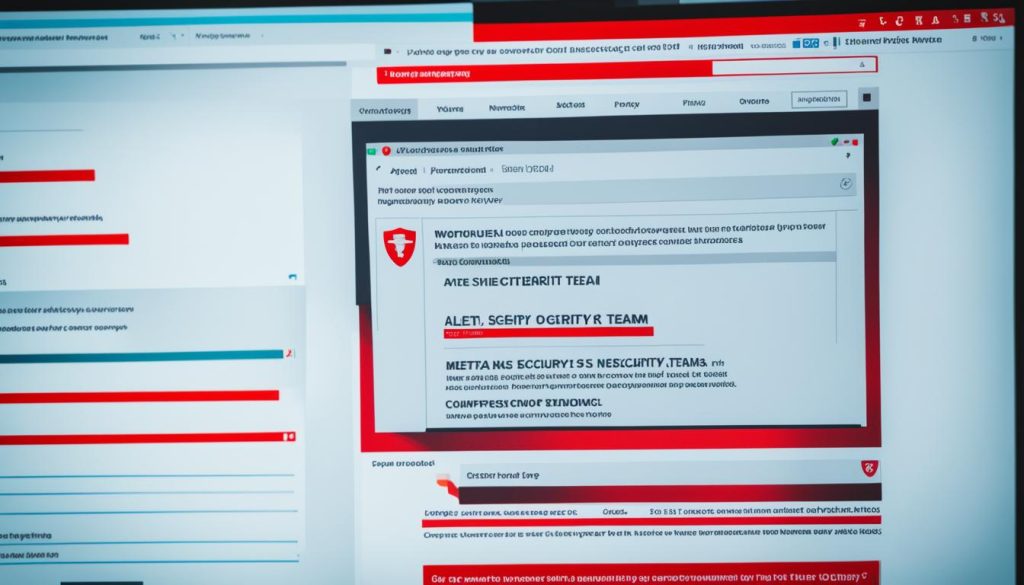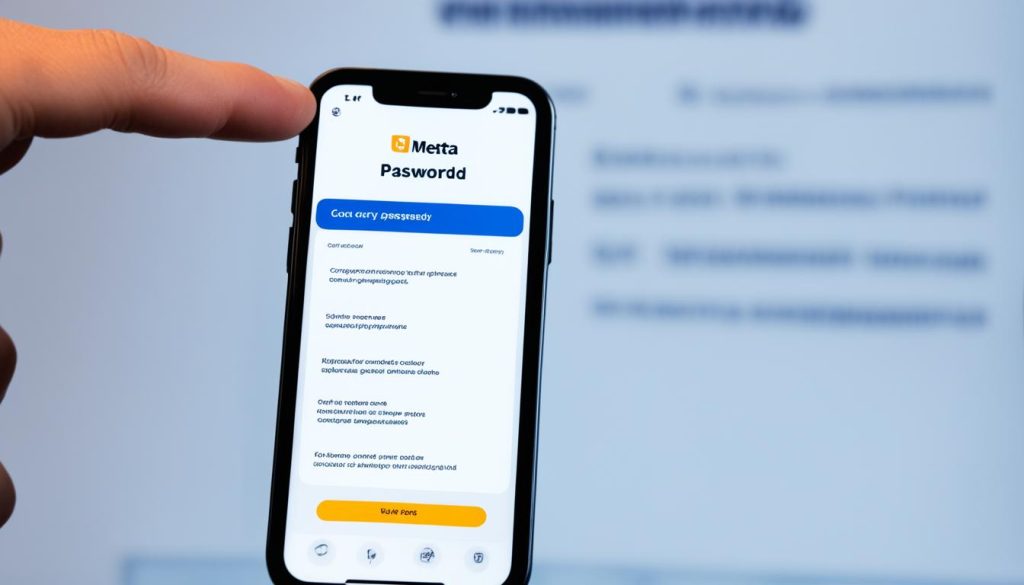In an era where being online is very important, online scams can harm both people and companies badly. The “Meta Security Team Disabled Page Scam” is a tricky one. It pretends to be a warning from Meta to scare users. Scammers use Meta’s trusted name to send fake messages. They say your account will be closed in 24 hours if you don’t act fast123. Our guide will teach you how to tell real messages from Meta apart from scams. You’ll learn how to protect yourself online.
Key Points:
- Be aware of scam messages pretending to be from the Meta Security Team, warning you about account closure.
- Never click on links or give out personal info if you get these fake messages.
- Keep your account safe by changing passwords, using two-factor authentication, and checking your account settings often.
- Always be careful and check any odd messages by reaching out to Meta directly through their official channels.
- Use cybersecurity tools like Malwarebytes to check for and get rid of any malware on your devices.
Understanding the Meta Security Team Disabled Page Scam

The Meta Security Team “Your Page Has Been Disabled” scam worries a lot of people in business. It pretends to be an official note from Meta, saying you broke the rules and now your page is gone. This trick is very clever and causes much stress.
These internet security frauds send out fake emails or messages with big claims to make you act fast4. They make you think you’ll lose your business online if you don’t fix things in 24 hours34. They ask for your private info—things like your login, phone number, and password3. If you give them this info, you could lose your page and even control of your online identity3.
To keep safe from the Meta Security Team scam, learn the warning signs. Real messages from big companies will come from their own email domains. They won’t use short links or ask for info over direct messages5. And they’ll speak to you like they know you, not with vague threats or asks5.
Being smart about cyber scams is the best way to defend yourself. Go to your accounts on your own, don’t click links in weird messages. Be suspicious of strange payment requests, like bitcoin or gift cards5. Use things like password managers and special keys for better safety3.
Raising scam alerts with others helps our whole community4. Sharing what we know and reporting scams makes us all safer online45. We must all help keep the internet a secure place by staying alert and reporting scams fast.
| Best Practice | Description | Benefit |
|---|---|---|
| Verify Communications | Check emails through official company websites. | Reduces risk of engaging with phishing attempts. |
| Password Management | Use password managers and change passwords regularly. | Helps in maintaining strong and unique password security. |
| Two-Factor Authentication | Activate 2FA using hardware keys or authentication apps. | Provides an additional layer of security for account access. |
| Security Tools | Utilize tools like Malwarebytes Premium to block malicious sites. | Prevents access to potentially dangerous websites. |
| Stay Informed | Regularly update oneself on common phishing tactics and scams. | Enhances personal vigilance against cyber fraud. |
| Report Suspicious Activity | Alert Facebook about the scam through proper channels. | Aid in reducing scam prevalence and protecting other users. |
To fight the Meta Security Team “Your Page Has Been Disabled” scam, follow good practices. Be alert for signs of fraud and educate yourself. Our best defense is knowing how to spot and avoid these scams345.
Meta Security Team “Your Page Has Been Disabled” Scam Explained

The page disabled scam uses fear to trick Meta Business Suite users. It sends a warning that looks like it’s from the Meta Security Team. You might see messages like “Your Page Has Been Disabled” or “Violations detected may result in your Page being removed.” It’s very important for companies to know these messages are fake and to stay vigilant against online scams.
You might get an urgent message saying your business account broke some rules. This could make you want to react fast, which is what the scammers hope for. The fake alert from the Meta Security Team is really a trick. It uses serious words and pictures to make you worried.
When you get a message like this, stop and think before you do anything. Check with Meta using their official ways of communication. The key is to check things out, not just believe them. This helps protect your online stuff from bad people.
Reference
- Look at where the message came from: usually, they’re not sent from official Meta emails.
- Be careful with links in the message; they might take you to fake sites that steal your info.
- Reach out to Meta the right way: use their official contact methods to see if the message was real.
A big tip for users of Meta Business Suite is to always question urgent warnings about your online space. Stop, think, and be careful before taking any action.
The Tactics Used by Scammers in Meta Phishing Attempts

Phishing scams are getting smarter, aiming to break into personal and business accounts. Cybercriminals are now faking Meta communications to trick people. This makes it hard to tell fake messages from real ones from the company.
Imitation of Official Communication
Scammers are good at copying Meta’s look and feel, making their messages seem real. They tell Facebook users their account is at risk to make them act fast6. They falsely claim there are issues with intellectual property to trick people who use the site a lot, abusing Meta’s trust7.
Creating Urgency to Provoke Immediate Action
Scams often say you have 24 hours to act or lose your account. This trick makes people act fast, without thinking if it’s real or not6. They play on emotions to get a quick, unthinking response7.
Phishing Pages Mimicking Meta Platforms
Scammers also make fake pages that look just like Meta’s real ones. They ask for your login info, pretending to check your account6. This risks your account and personal info, using tricky URLs7.
We need to alert everyone to fake Meta pages. Look for errors, strange emails, and odd links—these are signs of a scam6. Using tools like Malwarebytes keeps you safe from these traps6.
It is wise to check emails carefully and not click on weird links. Changing passwords and using 2FA keeps hackers out7. Go straight to Meta’s sites to check things out, avoiding scam links6.
In summary, phishing is a real danger online. Staying on top of these scams and following safety advice is key to avoid harm7.
Identifying the Signs of a Meta Page Disabled Scam

As more people get tricked by phishing, knowing the signs of scams is key for Facebook users. Fake emails may claim your account is at risk of being shut down. They often say you have only 24 hours to act or you’ll lose access forever34.
Scammers might pretend to be “Meta Business Support.” They send scary messages with bad links to trick page managers into giving away private info4. People should watch out for strange messages that don’t look like they’re from Meta. Clicking bad links or sharing your details can lead to big trouble3.
Spot fake emails by checking closely. Look for spelling errors, weird email addresses, and links that don’t go to Facebook3. Attackers now use pictures to get past security, so be extra careful with every email8.
| Scam Sign | Description | Recommended Action |
|---|---|---|
| Unexpected Urgency | Immediate threat to disable account or page | Verify directly on the Facebook platform |
| Suspicious Links | Embedded links leading to questionable web pages | Avoid clicking, report to Facebook |
| Language Errors | Clear typos and grammatical mistakes in the message | Dismiss as fraudulent |
| Impersonation | Using false identities of trusted entities | Check sender’s authenticity, report discrepancies |
Recognizing a Meta Security Team scam alert and reporting it helps everyone stay safe online4. The FBI says phishing is a top cybercrime, with attacks on businesses jumping from 72% to 86% in three years. This shows we need to keep learning about scams and how to report them8.
When everyone reports scams and shares what they know, it scares off the scammers. Using things like two-factor authentication, password managers, and Malwarebytes Premium strengthens our security. This way, being careful goes hand in hand with having strong protection3.
Protecting ourselves online is a continuous effort. Whether for personal or business use, staying alert and following safety tips helps safeguard our information and keeps the internet a safer place.
How the Fake Meta Security Team Messages Operate

Every day, your online accounts face threats from phishing scams. One example is the Meta Security Team disabled page fraudulent messages. They trick you by sounding urgent and warning about losing money3. If you get such a message, it will seem like it’s helping by asking you to act fast to avoid bad outcomes7.
The trick directs you to a fake link that looks real. Following their instructions can reveal your email and password3. These fake messages often have mistakes or weird sender emails that are not from Meta’s real domain3.
You risk getting caught by phishing when messages falsely claim your page will be disabled. They use fake official language and logos7.
The scam called Meta Security Team “Your Page Has Been Disabled” is tricky. It starts with messages pressing you to act fast and ends with stealing your info on pages that look real but aren’t7. This scam seems legitimate, aiming at both individuals and business owners worried about their online accounts9.
To avoid these scams, it’s crucial to take preventive steps. Don’t click on any links. Instead, go directly to your Facebook to check for issues. Use good security tools to block bad sites3. Changing your password often and using two-factor authentication add extra protection7.
| Scam Component | Typical Characteristics | Preventive Recommendations |
|---|---|---|
| Urgency and Financial Threat | Dire warnings leading to hastily actions | Direct account verification avoiding links |
| Data Collection | Requests for personal login information | Utilize password managers and 2FA |
| Recognizing the Scam | Miscues such as typos, odd URLs | Education on red flags, use of security tools |
| Reporting and Responsiveness | Report scam to platform, don’t follow links | Report immediately, change passwords |
Knowing how these scams work, you can stop them. Spotting scam tactics and following safety advice can protect your social media from harm37.
Technical Analysis of the Scam’s Execution

Online scams are growing, urging us to look closely at how they happen. A key focus is on phishing scams, showing how fraudsters use smart tricks to catch victims. They use fake web links and Facebook pages to trick internet users. By learning about these scams, people can spot and avoid them.
Anatomy of Phishing Links
Phishing links have signs that show they’re fake. They look like real websites to trick people. But small differences give them away. These links have weird strings or fake subdomains. These are warning signs you’re not on a real site.
Examination of Fake Facebook URLs
In fake Facebook URLs, real addresses are changed to make fake ones. They add things like extra. or -fb, use .info instead of .com, or swap letters. These tricks lead to false sites made for stealing personal data.
| Real Facebook URL | Fake Facebook URL | Indicator of Fraud |
|---|---|---|
| www.facebook.com | www.facebook-verify.com | Extra words and hyphens |
| facebook.com/login | faceb0ok.com/login | Character substitution (zero for ‘o’) |
| business.facebook.com | business.facebook.verify-login.info | Unusual subdomains and top-level domains |
To spot scam links, you must stay alert. Be careful with unexpected links or emails. Checking a link thoroughly can prevent falling for scams. Knowing what a fake link looks like is key to staying safe online.
Actions to Take If Your Meta Page is Wrongfully Disabled

If your page gets wrongly disabled, it’s important to act fast and smart. Given the rise in scams, staying alert is key. Here’s what you should do first if you think it’s a scam:
- Change your passwords to something complex and unique right away.
- Turn on two-factor authentication for better account protection.
- Check your account settings closely and fix any changes you didn’t make.
- Remove any apps connected to your Meta account that seem strange.
Next, make sure to talk to your friends and family. Letting them know about the scam can stop it from spreading. Also, checking your devices for malware is crucial to keep them safe from threats.
After dealing with the immediate issues, think about these next steps:
- Look into the latest tips from cybersecurity pros on what to do if you’re scammed.
- Find help or advice on cybersecurity for businesses with the Taxpayer Assistance Center Locator10.
- Stay up-to-date with security alerts to spot and fight off Meta scams better.
- Always keep an eye on your online activity to catch any unauthorized actions fast.
These steps will help you get back in control of your online life. Don’t forget, staying informed helps a lot. The IRS offers tools like the Where’s My Refund? Tool10, and the Tax Withholding Estimator10 for safe data management. These aren’t just for taxes; they show how keeping up with your info can protect you from phishing scams.
| Immediate Response | Long-Term Strategies |
|---|---|
| Change passwords | Stay updated on scam prevention guides |
| Enable two-factor authentication | Utilize Taxpayer Assistance Center Resources10 |
| Inspect and correct account settings | Monitor advisories from reputable sources |
| Unlink unfamiliar apps | Regularly review online presence |
Following Meta’s advice on what to do if your page is disabled can lessen the impact of security issues. By being well-informed and vigilant, you set up a strong defense against complex digital scams. This keeps your online experience safer.
Victims’ Reports: Real-Life Scam Examples

People have started to open up about their scam experiences due to more online fraud cases. They’ve been tricked by fake operations, thinking they’re dealing with reliable organizations like the Meta Security Team. Such first-hand accounts of phishing scams online scam testimonies highlight the cunning methods of internet fraudsters.
The FBI’s Internet Crime Complaint Center (IC3) recorded a shocking 847,376 victims’ reports of scams in 2021, leading to $6.9 billion in losses in the US11. Furthermore, the Global Anti Scam Alliance found a global loss of $47.8 billion in 2020. This was a huge increase from 139 million scams in 2019 to 266 million scams in 202011. These numbers show how real-life scam examples can help raise awareness and teach internet users to protect themselves.
Both government and private groups are fighting back against fraud. Websites like the FBI IC3 and ScamWatch ACCC play a vital role. They help the public spot and report scams. Groups like the Anti-Phishing Working Group (APWG) and ScamAdviser also contribute by providing essential information and resources11.
| Year | Reports of Scams | Losses in USD |
|---|---|---|
| 2020 | 266 million | $47.8 billion11 |
| 2021 | 847,376 | $6.9 billion11 |
The damages from these reports of Meta Security Team scam are huge, not just in money but in lost trust. People thought they were safe online. Now, they’re learning to question even authoritative-looking messages for genuineness.
In the end, stories from scam victims teach and warn us all. They show the importance of being cautious online. Let’s use these stories and efforts to create a safer online world. A place where schemers find it hard to trick an informed and vigilant community.
Protecting Your Online Presence Against the Disabled Page Scam

With new tricks like clone phishing and whaling, keeping your online self safe is more important than ever. All ages, young and old, might click on bad links8. It’s key to stay alert and use security tools to avoid these sneaky tricks.
To fight the Meta page-disabled scam, you need to know how it works. These fake messages look real and might trick you into sharing personal info8. They might use fake calendar invites to get your data. Always check the web address if something feels off, especially when it looks like it’s from Meta8.
Since 2020, phishing is the top cybercrime8. Attacks on companies have gone up since 20178. You need to guard your online world. Don’t share personal info lightly and double-check messages from big bosses, which might be scams8.
Voice and text message scams are on the rise too8. Keeping up with new tricks, like scams using QR codes, is key. Phishing tries to make you act fast. Remember, real companies won’t rush you for info or money8.
To stay safe, don’t click on links from strangers. Think twice before sharing your details. True organizations won’t make clear mistakes or demand info in shady ways8. Learn and act to keep yourself safe from scams like the Meta page-disabled trick.
Meta’s Official Response to Security Concerns
Recently, Meta addressed email scam tactics targeting its users. They have taken serious steps toward improving security on their platform. Their goal is to protect their digital world from harmful attacks.
Meta is working hard to keep users safe. They’ve shared Meta guidance and alerts to help people spot phishing tricks. These scams often fake urgency, claiming you’ve broken rules and your account is in trouble. To fight this, Meta is teaching users to pause and think twice to keep their accounts secure6.
Guidance and Alerts Issued by Meta
Meta’s advice is clear: always double-check scary messages by going directly to your Facebook. They warn against trusting sketchy links6. Users should look out for emails that just don’t seem right, like strange wording or odd email addresses6.
Meta’s Active Measures to Counter Scams
Meta won’t stop fighting to keep users safe. They insist on not sharing personal info with shady sources. This could lead to unauthorized access and loss of your account, unless you use extra security like 2FA6.
Meta’s defenses include many steps one can take to stay safe online. They suggest being cautious with suspicious emails, using password managers, securing accounts with 2FA hardware keys, and employing cybersecurity tools to keep dangerous sites at bay6.
Stay alert and follow Meta’s security advice to navigate online safely. Meta is committed to fighting scams and protecting its community from online threats.
The Role of User Vigilance in Preventing Scams
Online platforms have grown, making it more important for users to be alert against scams. Knowing how to stay safe online is essential in today’s world where scams are smarter. Being careful with online interactions helps people spot and stop scams.
Meta reminds users that urgent demands through odd channels are rare. Realizing this makes each person a key defender against threats. This protection extends to their personal info and the larger community.
Stopping scams isn’t just about tech tools; it’s about how people act on what they know. Studies from places like Harvard Business Review show that dealing with tricky issues like new ad tricks requires being alert and ready
Signing up for The Daily Alert helps people stay informed. It’s a way to learn ongoing ways to protect yourself online
As influencers aim for trust, users should critically view online content and offers. For instance, how respected brands handle sponsored content sets a high standard
Comparing scam prevention to personal growth methods, like time management for working parents, makes sense. Just as exercises can make one more efficient, checking online messages carefully boosts scam defense
In the end, user alertness combined with company honesty strengthens overall scam resistance. This team effort secures not just personal accounts but the entire online realm.
Recommendations for Secure Account Management
To keep online accounts safe, especially on Meta platforms, follow proven security tips. Scammers target Facebook users with fake emails. They falsely claim your account will be disabled to get personal info quickly, often saying you have 24 hours3.
Start by checking such emails and your Facebook directly on its official site. This move avoids scammer traps designed to steal your details like email and password3. Adding two-factor authentication boosts your Meta account’s security, making it harder to lose control3.
Always verify the origin of an email that claims your account has been disabled and avoid clicking on any links; instead go directly to the official website
Be on the alert for signs of phishing, like spelling errors and fake links. Protect against these dangers by examining emails closely, using direct website access, managing passwords well, and using hardware keys for extra security3.
Use advanced cybersecurity tools to fight these threats. Products like Malwarebytes Premium block harmful sites and defend against online attacks3. Below, a table shows important steps for a security-first approach to account management:
| Action | Purpose | Outcome |
|---|---|---|
| Verify emails and websites directly | To bypass phishing attempts and malicious links | Reduced risk of personal information being compromised |
| Implement two-factor authentication | Adding an extra layer of security for account access | Enhanced protection from unauthorized account use |
| Use password managers | To maintain strong and unique passwords securely | Lower chance of password theft or reuse |
| Utilize Malwarebytes Premium | To prevent access to potentially dangerous sites | Stronger defense against malware and online scams |
Beating the scammer’s rush tactic helps keep Meta accounts under your control. Doing so protects your online presence3.
What to Do When You Encounter Suspicious Activity on Meta
Meta’s network users should always be on the lookout for anything suspicious. If you find a fake email saying your account will get deleted if you don’t act fast, stay calm34. Check the message for phishing signs like requests for your login details or password3.
Reacting quickly but wisely to Meta’s suspicious activity is key to protecting your info and account. Use your judgement and take steps to stop scammers in their tracks3.
If you get weird emails about account issues or asking for your info, double-check your account on Facebook directly. This way, you can avoid risky sites and confirm any real issues without danger3.
Turning on two-factor authentication (2FA) and changing your password are smart moves to make right away34. Also, tell Meta’s security team about the scam and warn your friends to help stop the spread4. Here’s a quick guide to fight these threats:
- Navigate directly to the official Meta platform to verify any account-related claims.
- Avoid clicking on any links from unsolicited emails or messages.
- Change your password and enable Two-Factor Authentication (2FA) as precautionary steps4.
- Report the suspicious activity to Meta following their recommended procedures4.
- Alert your contacts about the fraudulent scheme to prevent its spread.
- Consider employing additional tools such as password managers and FIDO2 devices for bolstering your online security3.
- Use protective software like Malwarebytes Premium to block access to malicious websites3.
By being cautious and informed about Meta security steps, you help protect yourself and make the digital community safer for everyone.
Legal Recourse for Businesses Affected by the Scam
Businesses caught in online scam nets must first understand their legal options. This knowledge is crucial for reducing harm. Seeking legal help can lead to facing these crimes and making the scammers pay. Working with law enforcement is key as they have the skills and tools needed.
Collaboration With Law Enforcement
Alerting authorities about scams is essential. The chance of clicking on fake links via pressure tactics is high3. Quick and united efforts with the police matter. Reporting scams helps the police catch fraudsters fast.
Reporting Channels and Community Support
Good scam reporting channels and victim support are critical. They provide legal help and build a community where people can share stories and advice. Recognizing scam signs like spelling errors and odd links is vital3.
Before acting on emails, businesses should double-check them3. Using password managers, two-factor authentication keys, and tools like Malwarebytes Premium can protect against phishing3.
Tools and Resources for Enhancing Meta Page Security
Today, with cyber threats growing, protecting your Meta page is essential. Attacks, like phishing scams by the Meta Security Team1, have gotten more complex. Meta now offers improved security tools. These help businesses enhance their page’s security and fight off scams.
Scammers often pretend to be Meta to trick you1. They create a sense of urgency to steal your data quickly1. Meta users can fight back with tools like two-factor authentication and checking their account settings regularly for any suspicious activity1.
“Ensuring the integrity of your Meta account requires both vigilance and the deployment of reliable security tools. Don’t wait until an attack occurs, take a proactive stance by leveraging available resources and services to defend your digital foothold.”
Adding to Meta’s tools, using antivirus software like Malwarebytes Anti-Malware is a good step1. It’s a free service that finds and removes malware on various systems. So, it’s a strong partner in keeping your digital space safe1.
| Operating System | Security Steps with Malwarebytes |
|---|---|
| Windows | Complete scans and malware removal processes offered by Malwarebytes. |
| Mac | Usage of Malwarebytes to identify and cleanse any potentially unwanted programs. |
| Android | Application of Malwarebytes mobile version for continuous monitoring and protection. |
If you’re caught in a phishing scam, act fast1. Reset your passwords and warn others. Using security resources for Meta users helps fix issues and improves your protection. Adding security tools to your routine can lessen the risk and effects of phishing scams1.
- Change compromised passwords immediately.
- Enable two-factor authentication.
- Remove apps from your Meta account that are unfamiliar or unused.
- Monitor online accounts for irregularities.
- Use robust security tools for business pages, recommended by experts for continuous protection.
Improving Meta page security is a team effort1. Sharing knowledge and actively using trustworthy online resources is key1. By staying informed and vigilant, we can stop hackers from exploiting online spaces1.
Conclusion
The “Your Page Has Been Disabled” scam by the Meta Security Team is a real threat. It shows the need for better Internet security scam alert attention. This scam makes itself look real and rushes victims with a 24-hour deadline to act, making them easier to trick3. Always question unexpected messages. And be on the lookout for signs of scams, like spelling errors or links that don’t lead to Facebook3.
Using two-factor authentication (2FA) helps a lot in protecting against phishing. It makes sure you’re safer online3. Also, using Malwarebytes can stop you from going to harmful sites, adding another layer of safety3. We suggest checking your account directly on official sites instead of clicking on email links. And using FIDO2 devices for logging in can keep you safe from scams3.
To stay safe from Meta phishing, it’s not just about tools but also about being smart online. Following this guide can make you smarter at spotting scams. Together, we can stop these scams from affecting our online world3.
FAQ
What is the Meta Security Team “Your Page Has Been Disabled” scam?
How can I identify the signs of the Meta Security Team disabled page scam?
What should I do if I receive a message claiming my Meta page has been disabled?
Has Meta taken steps to address the disabled page scam?
How can I avoid falling for online scams like the disabled page scam?
What immediate actions should I take if I suspect I’ve been targeted by the disabled page scam?
What are some recommendations for secure account management to protect against scams?
Where can I report a Meta scam and seek help if I’ve been affected?
Are there legal actions I can take against scammers who falsely claim that my Meta page has been disabled?
What tools and resources are available to enhance the security of my Meta Business Page?
Links
- https://malwaretips.com/blogs/meta-security-team/
- https://higherinfogroup.com/the-meta-business-support-your-account-has-been-disabled-scam-dont-fall-victim/
- https://www.malwarebytes.com/blog/news/2023/02/urgent-facebook-phish-claims-your-accounts-been-disabled
- https://www.myantispyware.com/2023/09/22/your-page-has-been-disabled-scam-facebook/
- https://smbcommunity.lenovo.com/us/learn/resource-library/b/articles/posts/go-phish-how-to-spot-a-scam
- https://malwarebytes.com/blog/news/2023/02/urgent-facebook-phish-claims-your-accounts-been-disabled
- https://www.myantispyware.com/2023/08/17/meta-business-support-scam-debunking-the-i-n-c-international-concepts-alert/
- https://en.wikipedia.org/wiki/Phishing
- https://maisribatejo.pt/2023/10/15/cidadaos-pela-ciberseguranca-denunciam-scam-de-facebook-your-page-has-been-reported/
- https://www.irs.gov/
- https://en.wikipedia.org/wiki/Scam
Avoiding Online Scams Cybersecurity Awareness Disabled Page Scam Internet Scam Prevention Meta Security Team Fraud Meta Security Team Scam Online Security Threats Phishing Scam Guide
Last modified: May 2, 2024





